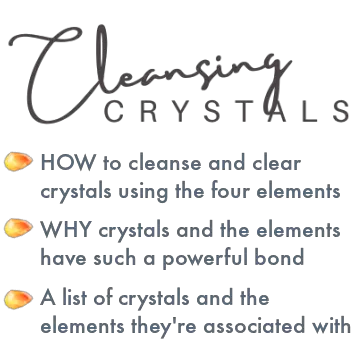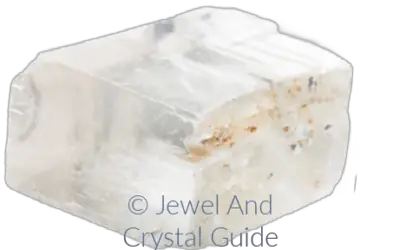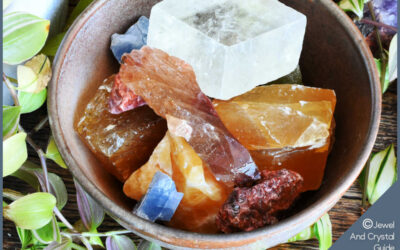A tiger’s eye crystal is beautiful when it shines, isn’t it?
It almost looks like a wild cat following you in a night light, hypnotizing you with its sheer magnificence.
Tiger’s eye has a rather unusual quality that makes it shine like that, but there are also things we can do to bring out the sparkle. And that’s what I’ll be covering today: What makes a tiger’s eye shine and how to make it as shiny as it can be.
In this blog post, you’ll find out:
- What special qualities make tiger’s eye shine
- How to get a tiger’s eye to glow
- What not to do so you don’t damage your crystal
6 reasons why tiger’s eye shines
Tiger’s eye shines because it…
Reflects bands of light
Have you ever seen a cat’s eyes glowing in the dark when a light or flash catches them?
This glow happens because the animal’s eyes don’t absorb the light but reflect most of it back, much like a mirror reflects a ray of light.
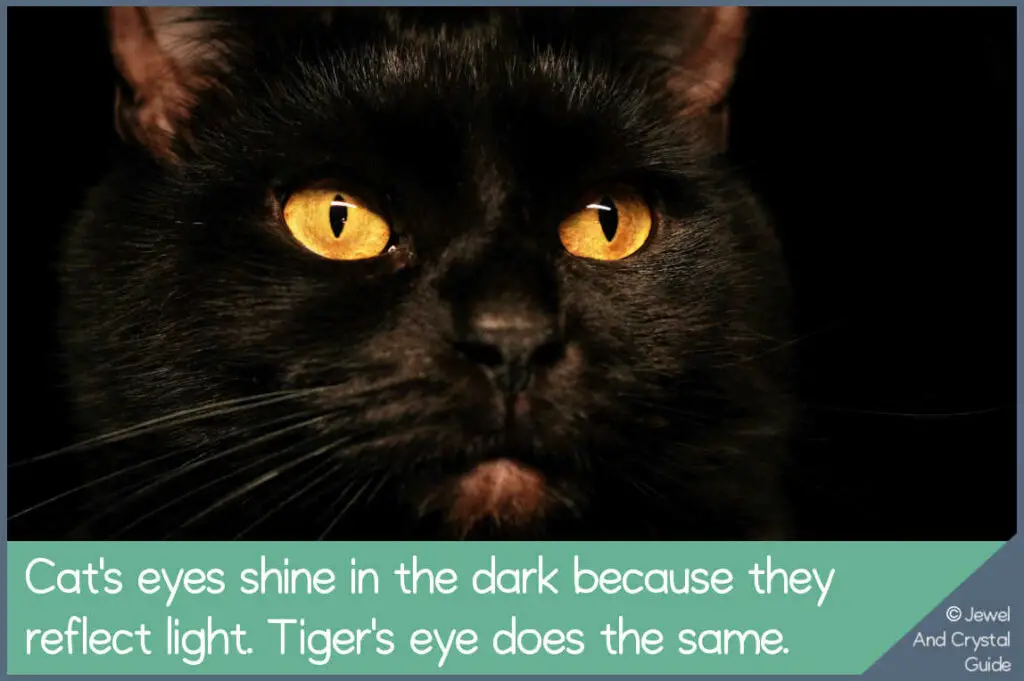
Tiger’s eye has a similar property that’s called “chatoyancy”.
Chatoyancy means that tiger’s eye reflects much more light than it absorbs, so light gets reflected back and makes it look like the crystal is shining.
But tiger’s eye doesn’t just reflect light, it reflects light in bands.
Tiger’s eye reflects a strip of light because it’s made of tiny reflective fibers that sit parallel to each other, with tube-like gaps between them.
When light hits the crystal, it reflects only off these fibers in a bright line, which reminds people of a tiger’s eye shining in a night light.
Moving a tiger’s eye crystal in the light changes the angle of this reflection, so the band of light seems to move with the crystal, as if it’s alive.
This reflected band of light is so cat-like that it’s one of the reasons why tiger’s eye is called tiger’s eye – because it looks like a tiger’s eye reflecting light at night.
The brilliant shine of a tiger’s eye crystal is called “chatoyancy.” It comes from the French words chat (cat) and oeil (eye), which mean cat eye.
Tiger’s eye isn’t the only crystal that’s chatoyant. Other crystals that shine with a band of light are chrysoberyl, pietersite, and quartz cat’s eye.
Contains iron oxide
Tiger’s eye mainly consists of iron and quartz, but it doesn’t start off this way.
At first, tiger’s eye contains crocidolite, which you might know as blue asbestos.
As the stone cracks under pressure and the asbestos inside gets exposed to oxygen, the iron in the asbestos blends with the oxygen to form iron oxide.
Iron oxide is a shiny, magnetic chemical mix that turns areas in tiger’s eye gold and brown.

And it’s these golden shades that shine in the light when you look at a tiger’s eye stone.
Tiger’s eye does come in different colors, depending on the minerals and how it was made. Click here to find out what colors there are and why they are so different.
Is tumbled
When tiger’s eye comes out of the ground, it’s rather rough and uneven. Click here to find out where it comes from and how it’s formed.
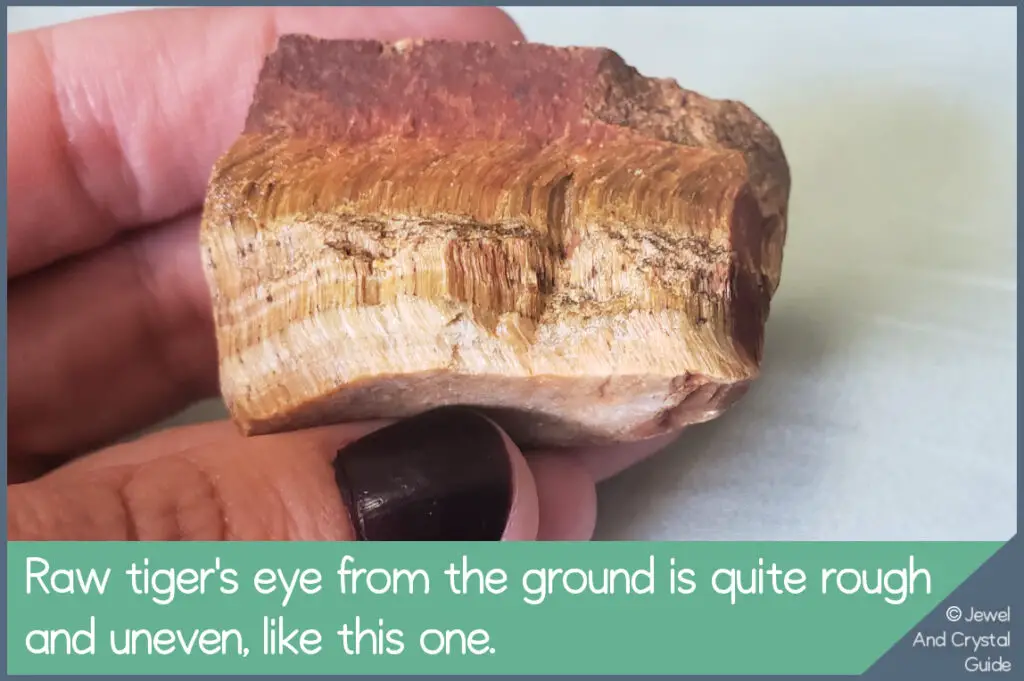
The raw rock can be tumbled in a machine, where it’s turned over and over again in a drum with other rocks, until it’s smooth and has lost its sharp edges. Tiger’s eye reflects more light like this, which makes it look shinier.
Hobbyists often tumble for fun in a tumbling machine like this one from National Geographic, or you can buy tumbled tiger’s eye that’s already shining from being tumbled.
Is polished
A polished tiger’s eye is a shiny tiger’s eye, so if you’re looking at a shiny crystal, there’s a good chance it’s polished.
Tiger’s eye is a quartz crystal. Quartz is hard and difficult to scratch or damage, so it can be polished to make it smooth and shiny.
To polish a tiger’s eye and make it shine, first wipe it clean with a damp cloth to remove dirt on the surface, then dry it off.
Next, polish it with diamond paste, like this one from Amazon. Polishing takes out scratches and smooths the surface, so the crystal shines as much as possible.
Please only use diamond paste on a stone that you are sure is real tiger’s eye, as man-made crystals with chemical dyes could get scratched and lose their color. Click here if you want to know how to tell real tiger’s eye from fake crystal.
Is oiled or sealed
An oiled tiger’s eye looks shiny because the oil reflects a lot of light.
Crystals are usually brightened with a commercial oil made for precious stones, and the diamond paste I mentioned above doesn’t only polish tiger’s eye, it also oils it to make it shine as much as possible.
Once a tiger’s eye is oiled and shining, here are 13 places to keep it.
Is heat treated
Heat makes some tiger’s eye crystals shine more because it makes the fibers inside more noticeable. And it’s these fibers that give the stone its chatoyancy, or shiny reflective quality.
But not all tiger’s eyes respond to heat the same way.
Crystals from different areas and crystals with different chemical structures have different reactions to heat, and it’s not always possible to predict these reactions until you’ve heated a crystal to see what happens.
It isn’t recommended that you heat tiger’s eye yourself – this tactic is best left to the professionals.
If you really want to do this yourself, heat tiger’s eye in the oven or with a torch. For the best results, keep the temperature between 390 and 750 °F (200 and 400 °C).
Any hotter than that and you could permanently damage the stone, crack it, fade it, or take away its chatoyant quality. This is usually what happens at around 840 °F (450 °C).






